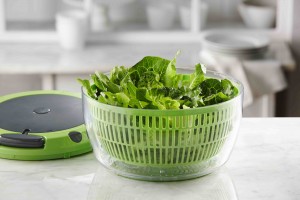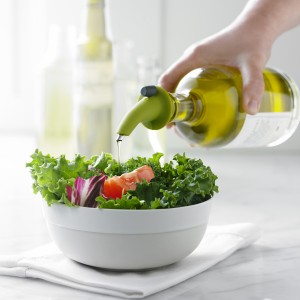Manufacturers Respond With Fresh Products for Fresh Produce
By Lorrie Baumann
Coached by a generation of chefs with television shows, consumers have learned to ask for fresh, local and organic products. Grocers are now teaching them to look for those at the grocery store as well as the farmers market, and housewares manufacturers and retailers are offering new products to help consumers make good use of their fresh produce once they get it back to their home kitchens.
“I think people are buying local now more than ever,” said Pat Brown, CEO of the Natural Food Group, which includes Mrs. Green’s Natural Market, Planet Organic Market and Richtree Natural Market restaurants in New York, the Mid-Atlantic, Chicago and Canada. Consumers are asking more questions now about where their food comes from, Brown said. “It forces the hand of the retailer to go out and get that product … Organic sales are growing at a high rate as well, but the consumer is interested in buying food in their neighborhood from people who grow it in their neighborhood.”
According to the U.S. Department of Agriculture, total local food sales last year amounted to $6.1 billion, of which only $1.31 billion in sales occurred directly from farmers to consumers through farmers markets, u-pick farms and farm stands. Sales from farms that passed through the hands of intermediates – restaurants, distributors and retailers – grew from $2.7 billion in 2008 to $3.35 billion in 2012.
Kitchenware manufacturers displaying their products at the International Home + Housewares Show this year demonstrated that they’re also aware of this trend and have been very busy over the past year developing products that respond to it. Trudeau, for instance, launched a 3 in 1 Salad Spinner that uses centrifugal force to separate water from produce without a pull cord. The patented gear-assisted system offers three speeds – high for drying lettuce, a medium speed for herbs and a low speed for drying delicate berries. The company also offers a Lettuce Saver bag made of a microfiber material that draws excess moisture away from freshly washed greens so they’ll stay fresher for longer in the refrigerator, Salad Scissor-Tongs with a take-apart pivot hinge so they can be used as conventional salad tongs or as individual servers and a Universal Dripless Spout that goes into the neck of the olive oil bottle from the grocery store to keep bottles clean and hands oil free when pouring the oil to dress the salad. And all those are just one example from many around the exhibit hall.
This proliferation of kitchenware products to meet the needs of shoppers interested in fresh, local foods is not a coincidence, according to Philippe Trudeau, President of Trudeau Corporation. “It’s funny how in our industry we have trends that everyone picks up on. You think you’re alone, and you have a great idea, and then you get to the show, and all of a sudden you realize you’re one of many companies working on the same thing,” he said. “Now we’re in a mode where we’re looking at what’s happening in society and what people are in tune with. As product developers, we pick up on these trends … We talk to our buyers; we talk to our consumers.”
In the nationally representative 2011 U.S. Grocery Shopper Trends Survey conducted by the Food Marketing Institute, more than four out of five of the surveyed grocery store shoppers reported that they purchased local foods occasionally, while almost one out of 10 says they purchased local foods whenever possible. The Specialty Food Association reported in its “The State of the Specialty Food Industry 2015” report that, according to specialty food manufacturers, “Local and all-natural products continue to be the most interesting to consumers. More than half of the manufacturers cited ‘local’ as a claim that interests consumers most today, with almost half of them expecting growth in local products over the next three years.”
Those who buy local foods are doing it because they want food that’s fresher and tastes better, and they want to support their local economy, rather than because they’re concerned for the environmental impacts of transporting food long distances. In a 2012 study, scientists found that grocery shoppers were more willing to pay extra for food labeled “local” than they were for foods labeled “certified organic,” “certified fair trade” or with a note about the food’s carbon footprint.
Some of those shoppers, particularly those who are white, upper to middle class and convinced that their buying habits can “make a difference,” are looking to farmers markets to supply their desires for fresh, local food – mainly produce – driving growth in the number of farmers markets across the country by 180 percent between 2006 and 2014. Conventional grocers haven’t missed the trend either. “Over the past five to six years, the focus on local, natural and organic has really taken hold among food retailers,” said Jim Hertel, Managing Partner for food retail consultants Willard Bishop.
Natural Markets Food Group has begun contracting directly with local farmers to provide produce to its markets in the Northeastern U.S. “At the peak of the season in the Northeast, we will be 65 or 70 percent local produce. That farmer used to sell produce in farmers markets … It’s exactly why we’re growing, that we’re able to create relationships with local farmers and bring their product in,” Brown said. “Other markets are doing the same thing.”
While not necessarily local, sales of organic products are following the consumer preference for fresh, trustworthy products. “That’s true both of natural foods retailers as well as more traditional mainstream food retailers, whether it’s Walmart, which has significantly ramped up emphasis on organics, especially value-priced organics,” said Hertel. “There’s been a recognition by retailers that consumers are interested and also that it’s an area where the margins are greater, so profits are greater.”
Sales of organic food in the United States totaled $35.9 billion in 2014, an 11 percent increase from the previous year, according to the latest data from the Organic Trade Association, which reported that total U.S. sales for organic products amounted to more than $39 billion in 2014, breaking previous industry records.
Sales research by the OTA shows sales trends for organic products growing at double digit rates for several years, compared to about a 1.5 percent projected growth rate for other foods. “The growth rates of traditional product lines are much smaller,” Hertel said. “The Millennial generation is very interested in healthy eating, and to them, that means natural and organic as well as less processed food.”
“It starts with the young people. I have two young daughters. They’re 16 and 18 and very sensitive to what they eat,” Trudeau said. “In our society, even teenagers are educated about what to eat, what’s good and what’s not.” Trudeau is developing kitchenwares products both for those young consumers who have been educated about eating fresher, less processed food and the Baby Boomers who may face more physical challenges as they age. “I am at the tail end of the Baby Boomers. We know that we’re not getting any younger,” Trudeau said. “There needs to be a conscious effort put into helping these people make food at home, helping people who may face physical challenges like carpal tunnel or arthritis. That’s what we think about all the time in developing our products.”
This story was originally published in the August 2015 issue of Kitchenware News, a publication of Oser Communications Group.



You must be logged in to post a comment.